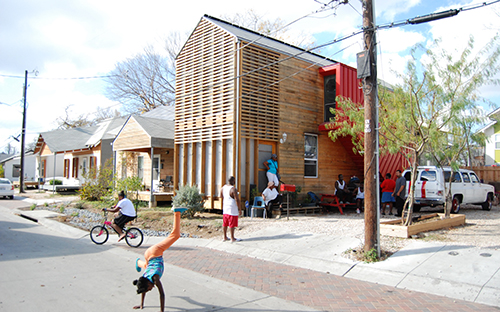After Hurricanes Dolly and Ike left many families in Texas’ Lower Rio Grande Valley with damaged housing, a team of designers, policy makers, community developers, and organizers worked with the communities to foster social, cultural, and economic resilience. Two of these individuals, Juanita Valdez-Cox, Executive Director, LUPE (La Unión Del Pueblo Entero), and Brent Brown,...
SIMS Municipal Recycling Facility in Brooklyn. Image courtesy of Selldorf Architects. Selldorf Architects, located at Manhattan’s Union Square, recently opened their studio to Cooper-Hewitt’s Design Watch Members. The firm has acquired an international reputation for work that is sensitive to context and program, thoughtful in execution and timeless. The firm has worked on public and...
Why? Contour Crafting is a construction technology that potentially reduces energy use and emissions by using a rapid-prototype or 3-D printing process to fabricate large components. Comprised of robotic arms and extrusion nozzles, a computer-controlled gantry system moves the nozzle back and forth, squeezing out layers of concrete or other material to fabricate a form....
Why? Preindustrial construction methods can provide fundamental lessons about sustainable design and environmental impact today. In this site-specific installation, thin tile vaults stretching across large spaces without formwork is part of a 700-year-old construction method that is energy-efficient, utilizes local materials, and achieves high structural strength. All of these factors have important applications in the...
Why? Preindustrial construction methods can provide fundamental lessons about sustainable design and environmental impact today. In this site-specific installation, thin tile vaults stretching across large spaces without formwork is part of a 700-year-old construction method that is energy-efficient, utilizes local materials, and achieves high structural strength. All of these factors have important applications in the...
Why? Loblolly House is comprised entirely of readymade components and elements fabricated off-site, reducing assembly time while increasing energy efficiency. The house comprises four key architectural elements: scaffold, cartridge, block, and equipment. The aluminum scaffold system provides the structural frame as well as the means to join the other three elements, using only a wrench....
An energy-efficient straw bale house is being built on the Mall, across the street from the US Capitol. Natural builders from around the country converged on Washington DC to construct the straw shelter and a bamboo shade structure. Rose Morin, a green builder from New Mexico and one of the over dozen volunteers with Builders...
The Vermelha chair is an iconic piece, originally conceived and prototyped in 1993 for a gallery show in São Paulo along with several other pieces. The construction of the chair is very time-intensive, as it is handmade from a huge length of rope wrapped and woven to create the chair’s structure. Though the piece is...
In sub-Saharan Africa, traditional building techniques are no longer feasible; due to increased deforestation use of timber for roofing and posts is not viable. Adapting an ancient architectural technique used in Sudan and Asia to West Africa, provides an affordable alternative. The Voute Nubienne (VN) or Nubian Vault technique uses local materials (mud bricks dried...
Exhibitions are hard work. At Cooper-Hewitt they are planned years in advance and involve several departments cooperating towards a common goal of creating the best exhibition possible. Once the research is completed, the objects chosen, the didactic panels and brochure text written, and the exhibition design layout completed, there is still one very important step...






